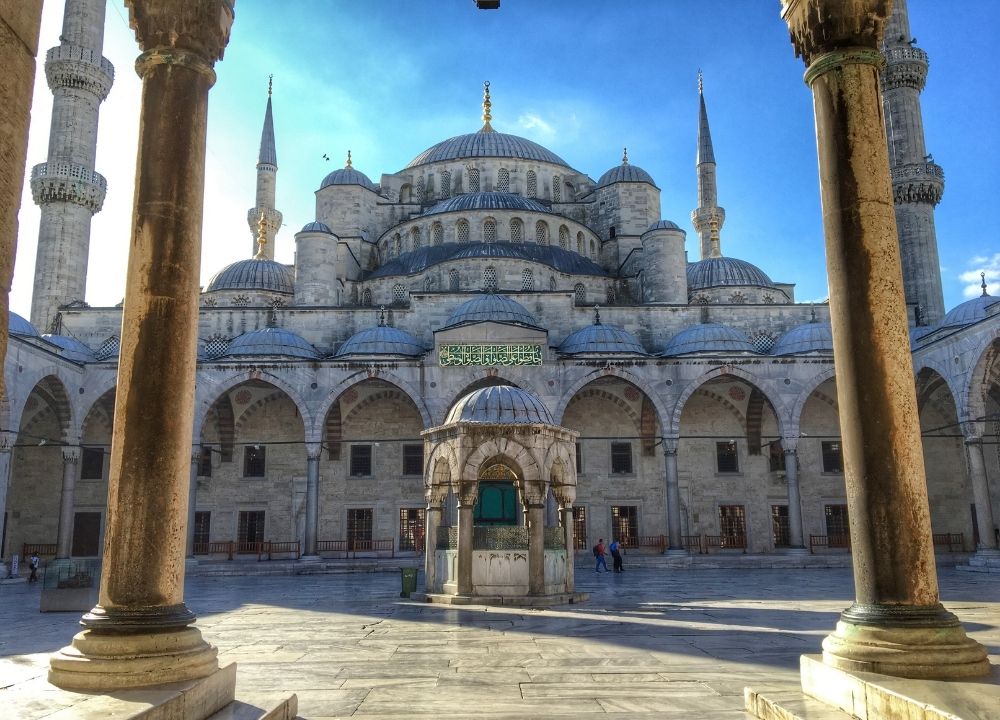Blue Mosque History and Architecture

Located on the historical peninsula of Istanbul, the Blue Mosque, famous for its minarets competing with the sky and its shades of blue, continues to fascinate its visitors. This magnificent mosque is also known as the "Blue Mosque" around the world and is of great historical and architectural significance.
The Blue Mosque was built during the rule of Ahmed I, the seventh sultan of the Ottoman Empire. Among the buildings constructed during this period, the mosque stands out both for its architectural excellence and its comprehensive design. The handcrafted Iznik tiles inside the mosque offer visitors a visual feast with the harmony of colors and patterns. Each tile reflects the artistic taste and mastery of the period.
The location of the Blue Mosque is also quite symbolic. Located right next to the Hagia Sophia, it reminds us that Istanbul is a center where religions and cultures embrace. The mosque and Hagia Sophia symbolize the transitions and interactions between Islam and Christianity. As visitors stroll between these two magnificent structures, they can feel how Istanbul has been a crossroads of cultures throughout history. This unifying atmosphere emphasizes the city's historical and cultural richness.
History of the Blue Mosque
The Blue Mosque was built between 1609-1616 by order of Sultan Ahmed I. Designed by architect Sedefkâr Mehmet Ağa, it is one of the last great mosque buildings of the classical period of the Ottoman Empire.
The mosque is named after Sultan Ahmed I, who had it built, and the "Blue Mosque" is named after the more than 20,000 blue, green and white Iznik tiles inside. These tiles, together with the light from the 260 windows illuminating the interior of the mosque, create a magnificent atmosphere.
The Construction Process of the Blue Mosque
When it was decided to build the Blue Mosque, it was a matter of great curiosity where in Istanbul would be the ideal location for this building. In the end, the area of the horse square of the Grand Palace was chosen. This area contained many buildings from the Byzantine and early Ottoman periods. Before the construction of the mosque began, these structures were demolished and a clean ground was prepared.
The architect Sedefkâr Mehmet Ağa was a student of Sinan and carried his master's mark on this grand project. The materials used in the construction of the mosque were brought from all over the Ottoman Empire. The stones came from Marmara Island, the pine trees from Edirne and the lead from Balıkesir.
The Magic of Tiles and the Unique Atmosphere of the Blue Mosque
Iznik tiles are one of the most remarkable features of the Blue Mosque. These tiles present the most brilliant examples of ceramic art of the Ottoman period. Each tile is handcrafted and decorated with various plant and geometric motifs. These tiles in blue, green and white tones create a magical atmosphere inside the mosque when combined with daylight.
The 260 windows in the mosque allow natural light to be evenly distributed inside. This window arrangement shows that the architect Sedefkâr Mehmet Ağa aimed for the light to hit the tiles evenly so that every corner of the mosque would be bright.
Architectural Features
The Blue Mosque stands out with its six minarets. These six minarets are a break from tradition, as Ottoman mosques usually have one, two or four minarets. In addition to the minarets, the main dome and the side domes of the mosque also offer a symmetrical balance, giving the mosque a sense of aesthetic unity when viewed from both inside and outside.
The Story of the Six Minarets
The six minarets of the Blue Mosque are a rare feature of Ottoman mosque architecture, and the subject of many narratives. According to one of the most popular narratives, Sultan Ahmed I requested golden ("gold" in Arabic) minarets for the mosque, but this request was misunderstood and made into six minarets. This story may have spread among the people to emphasize the uniqueness of the mosque.
The construction of these six minarets caused controversy as the other important mosque of the time, the Kaaba in Mecca, had only seven minarets. This was resolved when Sultan Ahmed I had another minaret added to the Kaaba.
Sympathy and Perfection of Domes
The main dome of the Blue Mosque is 23.5 meters in diameter and 43 meters high. Eight small domes around this main dome provide support by balancing the weight of the main dome. The four main columns of the mosque carry the weight of this dome. Each of these columns has a very wide structure and the careful placement of these huge stone structures shows the architectural success of the mosque.
The symmetrical arrangement of the side domes creates a harmonic atmosphere inside the mosque. These domes, together with the evenly distributed light inside the mosque, offer visitors a calm and peaceful environment. This architectural order ensures that the mosque achieves an aesthetic integrity both from the inside and the outside.
Sultanahmet View from Deraliye Terrace
After exploring the historical beauties in Istanbul, you should not return without stopping by Deraliye Terrace Restaurant, the perfect place to enjoy this unique view. Here, you can enjoy delicious meals accompanied by the magnificent view of the Blue Mosque. At sunset, under the silhouette of the mosque, the moments you spend at Deraliye Terrace will make your Istanbul experience unforgettable.
All in all, the Blue Mosque is an important part of Istanbul's historical and cultural heritage. After visiting this historic building, you can crown your day by sitting on the Deraliye Terrace and taking in the mesmerizing view of the mosque.


